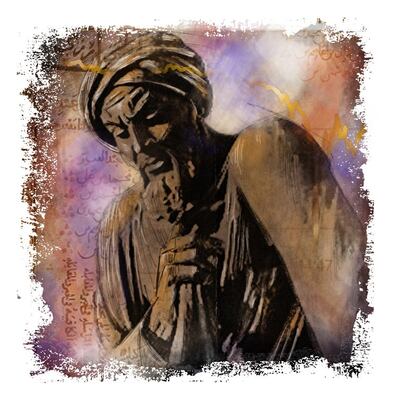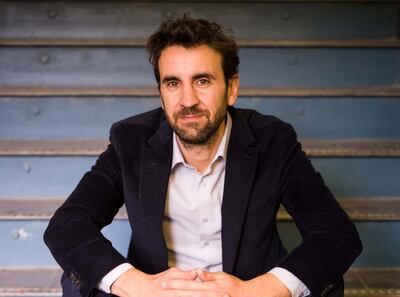A new art exhibition in Uzbekistan is exploring the eastern foundations of modern-day algorithms and computation, showing how the work of a 9th-century polymath laid out the building blocks for our digital world.
Muhammad Al-Khwarizmi is today afflicted by the curious fate of being a lesser-known historical figure, yet having his name suffused as an eponym in everyday language. After all, the word “algorithm” was derived from the Latin translation of Al-Khwarizmi’s name and its increased recent use is a faint linguistic evidence of how seminal the contributions of the historic mathematician and father of algebra have been to the digital age.
Even so, Al-Khwarizmi is often an overlooked figure when tracing the developments of modern-day computing systems. Technology we take to be cutting-edge, such as robotic automation and artificial intelligence, is built on the same basic principles theorised by Al-Khwarizmi more than 1,000 years ago. Search engines, tailored streaming and shopping suggestions, as well as navigational services, are all part of a mathematical lineage that can be traced to Al-Khwarizmi’s treatises.
The exhibition Dixit Algorizmi, which opened on October 5 at The Centre for Contemporary Art Tashkent, aims to highlight the links of modern-day technology to the Persian polymath. The exhibition is curated by architect Joseph Grima with the support of co-curators Sheida Ghomashchi and Camilo Oliveira. It includes works from musicians, filmographers, architects, designers and theorists, as well as visual, conceptual and textile artists, all of which help give a cross-disciplinary view of the enigmatic historic figure and his works.
“The algorithm shapes all the possible interactions in modern culture through the apps on our smartphones. We know the word but we don’t understand it. Through the multisensory and illustrative exhibition, we are retracing its origin and the great impact it has had on societies and cultures, from ancient to modern times,” says Grima, an architect, curator and critic.
Speaking to The National, Grima points out that many of Al-Khwarizmi’s mathematical breakthroughs came as he pondered on better systems to help the public divide inheritances under Islamic law.
“Division of inheritance can actually be incredibly complicated to carry out correctly through a simple abacus, which was essentially the only instrument of mathematical calculations that existed in Al-Khwarizmi’s time,” Grima says. “So a lot of his work was inspired by the idea of making people’s lives better and easier.”
Born in the 8th century in what is now Uzbekistan, Al-Khwarizmi was one of the most influential scientific figures of the Islamic Golden Age. The Persian polymath was an astronomer and the head librarian at the House of Wisdom in Baghdad during the Abbasid rule, and published treatises that proved to be major contributions to mathematics, astronomy and geography. It was Al-Khwarizmi that put forth the concept of a zero as a number, opening a new realm of mathematical possibilities.
Among Al-Khwarizmi’s most famous mathematical works are the treatises On the Calculation with Hindu Numerals and The Compendious Book on Calculation by Completion and Balancing, both of which were written around 820 CE. While the first treatise is credited with introducing the Hindu-Arabic numeral system to Europe, The Compendious Book is considered the first text to teach algebra for its own sake and was used as a principal textbook in European universities until the 16th century.
“The book was very influential,” Grima says. “It simplified lots of very tedious calculations and made them accessible to other people. More than 300 years after it was written, it was discovered by an English scholar living in Spain who translated it into Latin, which was the lingua franca of the science of Europe at the time, and [the book] became a transformative force in Europe.”
This original 1145 translation by Robert of Chester was given the title Dixit Algorizmi, from which the exhibition at The Centre for Contemporary Art Tashkent gets its name.
“Of course Algorizmi was a Latinisation of Al-Khwarizmi,” Grima says. “Because the whole of the book was essentially around this one idea of the algorithm, a mathematical approach to solving problems, the name of the author became synonymous with the thesis of the book.”
In the centuries-long process in which Latin was Anglicised, "algorizmi" morphed into "algorithm". However, it wasn’t until the late 19th century, as the first mechanical computers began to appear, that the word began seeing more frequent use.
“I become really obsessed with these lines across time and space that we use on a daily basis without really giving any thought to where their origins are,” Grima says. “In a way that’s a bit what the goal of the project is generally. To shine a light on this history.”
The works exhibited at Dixit Algorizmi are thematically linked to three different concepts, each of which provides a fresh perspective on the exhibition’s thesis.
The first section explores the notion of the portrait and the representation of Al-Khwarizmi today, especially with the lack of reliable historical and biographical information. The resulting works are a series of commissioned collaborations between international artists and Uzbek craftspeople.
“If you Google search Al-Khwarizmi, you’ll get a few different generic faces of Middle Eastern men that don’t quite relate to each other. So the idea of the exhibition is also asking artists to recreate this mystic figure,” co-curator and architect Oliveira says.
As part of the research process, the curatorial team took several trips to Uzbekistan, meeting with craftspeople and commissioning works for the exhibition.
“Our first visit was in 2019. We visited all the major cities of crafts in Uzbekistan,” Ghomashchi, an artist and co-curator of Dixit Algorizmi, says. “We visited different artisans and their workshops.”
“Initially the plan was to invite a few artists to travel to Uzbekistan and find out what the figure of Al-Khwarizmi meant to people today,” she says. “Unfortunately, because of Covid-19, not a lot of people managed that. Two of our artists directly engaged with the craftspeople of different regions to create a contemporary work.”
The exhibition’s second section highlights the numerous ways in which the ideas first articulated by Al-Khwarizmi transformed our ability to interact with each other and our surroundings through technology. The third theme presents several redefinitions of our understanding of algorithms. On show are texts and diagrams in the form of posters contributed by international artists, writers and scholars whose work investigates the relationship between everyday life and the history of science and technology.
“Everyone was really bold considering the size of the team, which came together from all corners of the world,” Ghomashchi says. “This diversity and boldness is really rare to find these days in an exhibition. I love that about all the artists and exhibited works.”
Though the exhibition cannot be accessed virtually, Grima says there are plans for it to travel the world, with efforts under way to bring Dixit Algorizmi to the UAE. However, a public programme related to the exhibition, which features panel discussions as well as talks by Uzbek craftspeople, will be available online.
More information on Dixit Algorizmi and its programme can be found at www.ccat.uz
Mohammed bin Zayed Majlis
Women’s T20 World Cup Asia Qualifier
ICC Academy, November 22-28
UAE fixtures
Nov 22, v Malaysia
Nov 23, v Hong Kong
Nov 25, v Bhutan
Nov 26, v Kuwait
Nov 28, v Nepal
ICC T20I rankings
14. Nepal
17. UAE
25. Hong Kong
34. Kuwait
35. Malaysia
44. Bhutan
UAE squad
Chaya Mughal (captain), Natasha Cherriath, Samaira Dharnidharka, Kavisha Egodage, Mahika Gaur, Priyanjali Jain, Suraksha Kotte, Vaishnave Mahesh, Judit Peter, Esha Rohit, Theertha Satish, Chamani Seneviratne, Khushi Sharma, Subha Venkataraman
Classification of skills
A worker is categorised as skilled by the MOHRE based on nine levels given in the International Standard Classification of Occupations (ISCO) issued by the International Labour Organisation.
A skilled worker would be someone at a professional level (levels 1 – 5) which includes managers, professionals, technicians and associate professionals, clerical support workers, and service and sales workers.
The worker must also have an attested educational certificate higher than secondary or an equivalent certification, and earn a monthly salary of at least Dh4,000.
The Sand Castle
Director: Matty Brown
Stars: Nadine Labaki, Ziad Bakri, Zain Al Rafeea, Riman Al Rafeea
Rating: 2.5/5
What is cyberbullying?
Cyberbullying or online bullying could take many forms such as sending unkind or rude messages to someone, socially isolating people from groups, sharing embarrassing pictures of them, or spreading rumors about them.
Cyberbullying can take place on various platforms such as messages, on social media, on group chats, or games.
Parents should watch out for behavioural changes in their children.
When children are being bullied they they may be feel embarrassed and isolated, so parents should watch out for signs of signs of depression and anxiety
In numbers: PKK’s money network in Europe
Germany: PKK collectors typically bring in $18 million in cash a year – amount has trebled since 2010
Revolutionary tax: Investigators say about $2 million a year raised from ‘tax collection’ around Marseille
Extortion: Gunman convicted in 2023 of demanding $10,000 from Kurdish businessman in Stockholm
Drug trade: PKK income claimed by Turkish anti-drugs force in 2024 to be as high as $500 million a year
Denmark: PKK one of two terrorist groups along with Iranian separatists ASMLA to raise “two-digit million amounts”
Contributions: Hundreds of euros expected from typical Kurdish families and thousands from business owners
TV channel: Kurdish Roj TV accounts frozen and went bankrupt after Denmark fined it more than $1 million over PKK links in 2013
Greatest of All Time
Starring: Vijay, Sneha, Prashanth, Prabhu Deva, Mohan
The%20specs%3A%202024%20Mercedes%20E200
%3Cp%3E%3Cstrong%3EEngine%3A%20%3C%2Fstrong%3E2.0-litre%20four-cyl%20turbo%20%2B%20mild%20hybrid%0D%3Cbr%3E%3Cstrong%3EPower%3A%20%3C%2Fstrong%3E204hp%20at%205%2C800rpm%20%2B23hp%20hybrid%20boost%0D%3Cbr%3E%3Cstrong%3ETorque%3A%20%3C%2Fstrong%3E320Nm%20at%201%2C800rpm%20%2B205Nm%20hybrid%20boost%0D%3Cbr%3E%3Cstrong%3ETransmission%3A%20%3C%2Fstrong%3E9-speed%20auto%0D%3Cbr%3E%3Cstrong%3EFuel%20consumption%3A%20%3C%2Fstrong%3E7.3L%2F100km%0D%3Cbr%3E%3Cstrong%3EOn%20sale%3A%20%3C%2Fstrong%3ENovember%2FDecember%0D%3Cbr%3E%3Cstrong%3EPrice%3A%20%3C%2Fstrong%3EFrom%20Dh205%2C000%20(estimate)%3C%2Fp%3E%0A
It Was Just an Accident
Director: Jafar Panahi
Stars: Vahid Mobasseri, Mariam Afshari, Ebrahim Azizi, Hadis Pakbaten, Majid Panahi, Mohamad Ali Elyasmehr
Rating: 4/5
Essentials
The flights
Emirates and Etihad fly direct from the UAE to Geneva from Dh2,845 return, including taxes. The flight takes 6 hours.
The package
Clinique La Prairie offers a variety of programmes. A six-night Master Detox costs from 14,900 Swiss francs (Dh57,655), including all food, accommodation and a set schedule of medical consultations and spa treatments.
The Perfect Couple
Starring: Nicole Kidman, Liev Schreiber, Jack Reynor
Creator: Jenna Lamia
Rating: 3/5
Infiniti QX80 specs
Engine: twin-turbocharged 3.5-liter V6
Power: 450hp
Torque: 700Nm
Price: From Dh450,000, Autograph model from Dh510,000
Available: Now
The specs: 2018 Audi RS5
Price, base: Dh359,200
Engine: 2.9L twin-turbo V6
Transmission: Eight-speed automatic
Power: 450hp at 5,700rpm
Torque: 600Nm at 1,900rpm
Fuel economy, combined: 8.7L / 100km
How to watch Ireland v Pakistan in UAE
When: The one-off Test starts on Friday, May 11
What time: Each day’s play is scheduled to start at 2pm UAE time.
TV: The match will be broadcast on OSN Sports Cricket HD. Subscribers to the channel can also stream the action live on OSN Play.
Types of fraud
Phishing: Fraudsters send an unsolicited email that appears to be from a financial institution or online retailer. The hoax email requests that you provide sensitive information, often by clicking on to a link leading to a fake website.
Smishing: The SMS equivalent of phishing. Fraudsters falsify the telephone number through “text spoofing,” so that it appears to be a genuine text from the bank.
Vishing: The telephone equivalent of phishing and smishing. Fraudsters may pose as bank staff, police or government officials. They may persuade the consumer to transfer money or divulge personal information.
SIM swap: Fraudsters duplicate the SIM of your mobile number without your knowledge or authorisation, allowing them to conduct financial transactions with your bank.
Identity theft: Someone illegally obtains your confidential information, through various ways, such as theft of your wallet, bank and utility bill statements, computer intrusion and social networks.
Prize scams: Fraudsters claiming to be authorised representatives from well-known organisations (such as Etisalat, du, Dubai Shopping Festival, Expo2020, Lulu Hypermarket etc) contact victims to tell them they have won a cash prize and request them to share confidential banking details to transfer the prize money.
* Nada El Sawy
Company Profile
Company name: OneOrder
Started: October 2021
Founders: Tamer Amer and Karim Maurice
Based: Cairo, Egypt
Industry: technology, logistics
Investors: A15 and self-funded
Indoor Cricket World Cup Dubai 2017
Venue Insportz, Dubai; Admission Free
Day 1 fixtures (Saturday)
Men 1.45pm, Malaysia v Australia (Court 1); Singapore v India (Court 2); UAE v New Zealand (Court 3); South Africa v Sri Lanka (Court 4)
Women Noon, New Zealand v South Africa (Court 3); England v UAE (Court 4); 5.15pm, Australia v UAE (Court 3); England v New Zealand (Court 4)
The Voice of Hind Rajab
Starring: Saja Kilani, Clara Khoury, Motaz Malhees
Director: Kaouther Ben Hania
Rating: 4/5
GRAN%20TURISMO
%3Cp%3E%3Cstrong%3EDirector%3A%3C%2Fstrong%3E%20Neill%20Blomkamp%3C%2Fp%3E%0A%3Cp%3E%3Cstrong%3EStars%3A%3C%2Fstrong%3E%20David%20Harbour%2C%20Orlando%20Bloom%2C%20Archie%20Madekwe%2C%20Darren%20Barnet%3C%2Fp%3E%0A%3Cp%3E%3Cstrong%3ERating%3A%3C%2Fstrong%3E%203%2F5%3C%2Fp%3E%0A
The biog
Alwyn Stephen says much of his success is a result of taking an educated chance on business decisions.
His advice to anyone starting out in business is to have no fear as life is about taking on challenges.
“If you have the ambition and dream of something, follow that dream, be positive, determined and set goals.
"Nothing and no-one can stop you from succeeding with the right work application, and a little bit of luck along the way.”
Mr Stephen sells his luxury fragrances at selected perfumeries around the UAE, including the House of Niche Boutique in Al Seef.
He relaxes by spending time with his family at home, and enjoying his wife’s India cooking.
Red flags
- Promises of high, fixed or 'guaranteed' returns.
- Unregulated structured products or complex investments often used to bypass traditional safeguards.
- Lack of clear information, vague language, no access to audited financials.
- Overseas companies targeting investors in other jurisdictions - this can make legal recovery difficult.
- Hard-selling tactics - creating urgency, offering 'exclusive' deals.
Courtesy: Carol Glynn, founder of Conscious Finance Coaching













